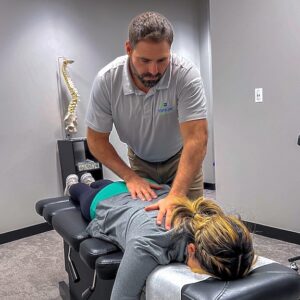Soft wave therapy, a cutting-edge approach in the realm of healthcare, has been gaining traction as an effective treatment for various conditions. From chronic pain to tissue repair, this innovative technique offers promising results. However, when considering treatment options, it’s crucial to understand how soft wave therapy compares to other available alternatives. In this comprehensive guide, we will delve into the intricacies of soft wave therapy and juxtapose it against conventional treatments like medication, physical therapy, and surgery.
Understanding Soft Wave Therapy
Soft wave therapy, also known as shockwave therapy, involves the application of acoustic waves to the affected area of the body. These waves carry energy that stimulates healing and regeneration processes within tissues. The therapy is non-invasive and has shown remarkable effectiveness in treating conditions such as:
Biophysical Effects: Soft wave therapy, a form of extracorporeal shockwave therapy (ESWT), operates through acoustic waves that propagate into the tissues. These waves induce controlled microtrauma at the cellular level, initiating a cascade of biophysical effects. This trauma stimulates the release of biochemical mediators, including adenosine triphosphate (ATP), prostaglandins, and growth factors, triggering cellular repair mechanisms. Furthermore, the mechanical forces generated by these waves enhance cell membrane permeability, facilitating the influx of nutrients and oxygen while expelling waste products, thereby fostering tissue regeneration.
Cellular Healing Mechanisms: At a cellular level, soft wave therapy prompts intricate healing mechanisms. It promotes the release of nitric oxide, a potent vasodilator that improves blood flow, stimulating the proliferation of endothelial progenitor cells and angiogenesis. Moreover, it encourages the secretion of vascular endothelial growth factor (VEGF), a crucial element in angiogenesis and tissue repair. The therapy also modulates the expression of various cytokines, influencing inflammation and immune responses to optimize the healing environment.
Different Wave Frequencies and Depths: Soft wave therapy devices offer a range of settings that enable clinicians to adjust treatment parameters based on the specific pathology and depth of the affected tissues. Higher-energy shockwaves penetrate deeper into tissues, making them suitable for conditions requiring treatment at deeper levels, such as chronic tendinopathies or deep-seated musculoskeletal issues. Conversely, lower-energy waves are utilized for more superficial ailments, ensuring precision targeting and efficacy in addressing specific areas.
Neuromodulatory Effects: Soft wave therapy extends beyond tissue repair to influence nerve conduction and pain perception. Studies suggest that these acoustic waves modulate pain signals by affecting nerve transmission, resulting in pain reduction and improved functional outcomes for chronic pain conditions. By altering neuronal activity and reducing neurogenic inflammation, the therapy offers notable relief from pain.
Immunomodulatory Properties: Soft wave therapy exhibits immunomodulatory effects by influencing the immune response within treated tissues. It stimulates the release of anti-inflammatory cytokines while downregulating pro-inflammatory cytokines. This modulation helps in controlling chronic inflammation, creating a conducive environment for tissue repair and accelerated healing.
Bone Healing Enhancement: In addition to its impact on soft tissues, soft wave therapy plays a significant role in bone healing processes. It accelerates fracture healing by stimulating osteoblast activity, promoting the deposition of new bone matrix, and facilitating bone remodeling. This feature makes it an invaluable adjunct therapy for individuals recovering from fractures or orthopedic surgeries, expediting their healing and recovery.
Long-Term Healing Effects: Beyond immediate pain relief, soft wave therapy demonstrates long-term benefits owing to its capacity to stimulate tissue regeneration and repair. The sustained activation of cellular repair mechanisms continues even after the completion of treatment sessions. This sustained healing effect contributes to long-lasting relief from chronic conditions, promoting enhanced functional outcomes over time.
Treatment Customization for Individuals: Soft wave therapy offers a high degree of treatment customization. Clinicians can tailor treatment parameters such as wave intensity, frequency, and application technique to suit the unique needs and responses of individual patients. This personalized approach optimizes treatment efficacy and outcomes, ensuring that each patient receives targeted and effective care based on their specific condition.
No Known Serious Adverse Effects: Extensive research and clinical studies have demonstrated the safety profile of soft wave therapy. While some patients may experience mild discomfort or temporary soreness immediately after treatment, severe complications or long-term adverse effects are exceedingly rare. The therapy is generally well-tolerated by patients across different age groups and conditions.
Evolving Research and Future Potential: Ongoing research efforts continually explore the potential applications and mechanisms of soft wave therapy in various medical fields. With its proven efficacy and safety, ongoing studies aim to expand its utility to new conditions, potentially revolutionizing treatment approaches in healthcare. As research progresses, soft wave therapy is poised to become an increasingly integral part of comprehensive treatment plans across numerous medical specialties, offering novel solutions to diverse healthcare challenges.
Soft Wave Therapy vs. Medication
Traditional approaches often involve medication to manage pain and inflammation. While medications offer temporary relief, they may come with side effects and the risk of dependency. In contrast, soft wave therapy targets the root cause of the issue by promoting the body’s natural healing mechanisms. It doesn’t involve drugs, making it a non-invasive alternative with fewer associated risks.
Soft Wave Therapy vs. Physical Therapy
Physical therapy focuses on rehabilitation through exercises and manual techniques. While it’s beneficial for many conditions, it may take longer to achieve results. Soft wave therapy, on the other hand, accelerates the healing process by stimulating cellular repair, complementing the effects of physical therapy. Combining both approaches can often yield superior outcomes for patients.
Soft Wave Therapy vs. Surgery
Surgery is often considered a last resort for many conditions. Soft wave therapy, being non-invasive, presents a compelling alternative for those looking to avoid surgical intervention. It offers a viable option, particularly for individuals seeking a non-surgical approach to address their ailments.
Benefits of Soft Wave Therapy
Non-Invasive Approach: Soft wave therapy’s non-invasive nature ensures patient comfort and safety. By employing acoustic waves directed towards the affected area, it bypasses the need for surgical incisions or invasive procedures. This minimizes trauma to surrounding tissues, reduces the risk of infections, eliminates post-operative recovery periods, and mitigates potential complications that may arise from invasive interventions. Patients benefit from a treatment that is gentle, painless, and significantly decreases the risks associated with traditional surgeries.
Effective Pain Relief: Soft wave therapy near me offers a highly effective solution for pain relief by addressing the underlying cause of discomfort. Through the stimulation of the body’s natural healing processes and the reduction of inflammation, it not only alleviates pain but also actively contributes to resolving its origin. This mechanism provides a sustainable approach to pain management, reducing the reliance on pharmaceuticals and their potential side effects, while offering long-term relief for chronic pain conditions.
Accelerated Healing: The application of acoustic waves in soft wave therapy accelerates the body’s innate healing mechanisms. This rapid stimulation leads to heightened tissue repair and regeneration, facilitating expedited recovery times for various musculoskeletal injuries and chronic conditions. By hastening the healing process, patients experience quicker restoration of functionality and reduced downtime, allowing them to return to their regular activities sooner.
Improved Blood Circulation: Soft wave therapy’s ability to enhance blood circulation within the targeted area promotes better oxygenation and nutrient delivery to tissues. The increased blood flow aids in removing metabolic waste products and toxins, facilitating a more efficient healing process. Improved circulation supports the restoration of damaged tissues by providing essential resources required for optimal recovery.
Reduced Scar Tissue Formation: A notable advantage of soft wave therapy is its capacity to break down scar tissue and calcifications. This action diminishes the formation of rigid or restrictive scar tissue, thereby improving flexibility and decreasing discomfort associated with adhesions. Patients benefit from increased mobility and reduced pain, contributing to an improved quality of life.
Minimal Side Effects: Soft wave therapy is generally well-tolerated by most individuals, resulting in minimal adverse effects. Its non-invasive nature significantly reduces the likelihood of post-treatment complications, allergic reactions, or undesirable side effects commonly associated with medications or surgical interventions. Patients experience a treatment modality that is safer and poses fewer risks to their overall well-being.
Customizable Treatment Plans: The versatility of soft wave therapy allows healthcare providers to tailor treatment intensity and frequency according to each patient’s specific condition and needs. This personalized approach ensures that individuals receive optimized treatment plans aligned with their unique recovery goals. Customization enhances the therapy’s effectiveness and improves patient outcomes.
Versatile Application: Soft wave therapy’s versatility enables its application across a spectrum of conditions, including musculoskeletal injuries like tendonitis, plantar fasciitis, and orthopedic conditions such as arthritis. Its adaptability to different ailments affecting bones, muscles, and soft tissues makes it a viable option for addressing a wide array of medical issues, providing patients with diverse treatment possibilities.
Non-Addictive Pain Management: Soft wave therapy provides a non-addictive alternative for managing pain without the use of pharmaceuticals. By offering a drug-free approach to pain relief, it significantly reduces the risk of patients developing dependencies or addiction to painkillers. This aspect ensures a safer and more sustainable solution for managing discomfort in the long term.
Complementary Treatment: Soft wave therapy seamlessly integrates with various therapeutic modalities, including physical therapy, chiropractic care, or post-operative rehabilitation. When combined with these treatments, it synergistically enhances overall treatment efficacy, facilitating better outcomes, and expediting the recovery process for patients. This integrative approach maximizes the benefits of each treatment modality, providing a comprehensive and holistic approach to healthcare.
Soft wave therapy emerges as a promising treatment option across various conditions, offering a non-invasive, drug-free approach to healing. While it may not replace all conventional treatments, its efficacy and minimal side effects make it a compelling choice for many patients seeking effective and safer alternatives.
When considering soft wave therapy or any other treatment, consulting healthcare professionals like the experts at Evolve Chiropractic of Rockford can provide personalized guidance. Understanding the nuances of each treatment option is crucial in making informed healthcare decisions tailored to individual needs.
In the dynamic landscape of healthcare, innovations like soft wave therapy Rockford continue to redefine treatment paradigms, offering renewed hope and effective solutions for patients seeking holistic and advanced care.
2606 Broadway #1a, Rockford, IL 61108, United States
(815) 397-7259
https://myevolvechiropractor.com/chiropractor-in-rockford-il





